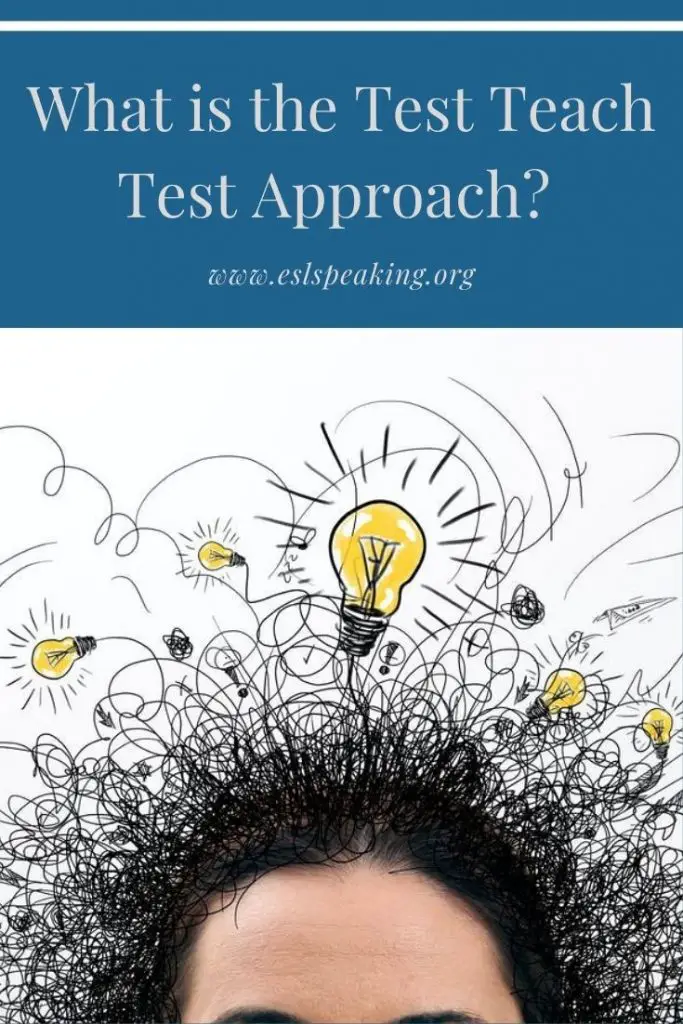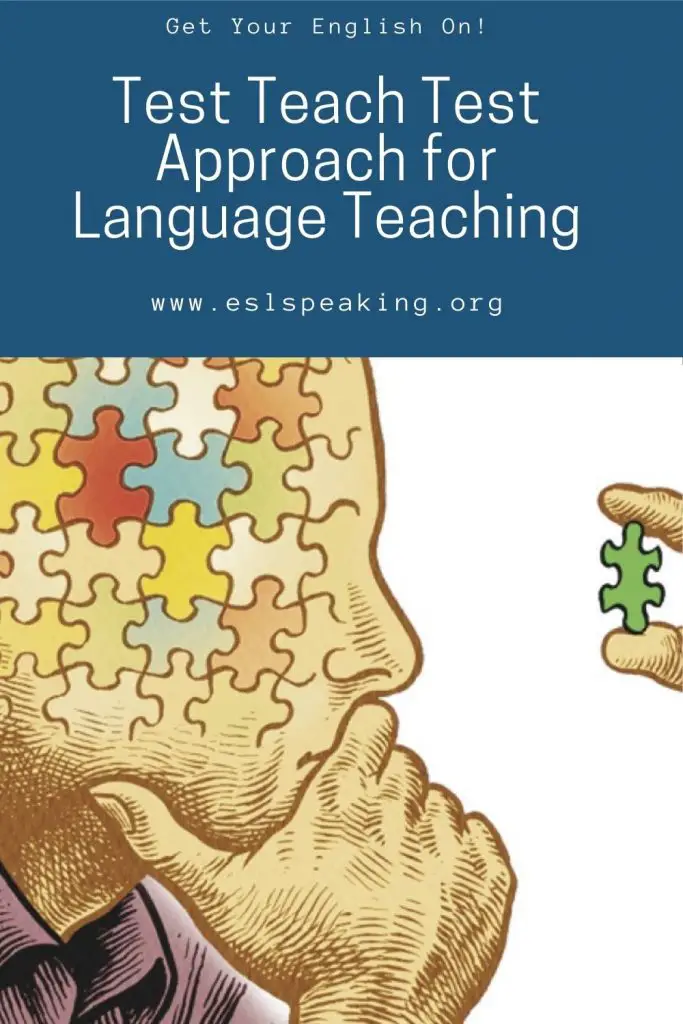If you’re looking to keep things fresh and interesting in your language class, then you’re in the right place! Try out the test teach test approach (TTT), which can be a nice change of pace.
I’ll give a rundown on what Test-Teach-Test is, the advantages and disadvantages, when to use it or not, as well as some activities that work well for each stage. Keep on reading for all the details you need to know about TTT and give it a try in your classes.

An Introduction to Test Teach Test
Test Teach Test (also known as TTT) is a language teaching approach where students complete diagnostic tests at the beginning of the lesson, without help from the teacher. After looking at the results, the teacher plans and presents a lesson based on the students’ specific needs. Finally, learners can do a task (test) at the end to put into practice what they’re learned.
3 Parts to TTT
There are three stages to this style of lesson. I’ll talk about each of them in more detail here.
#1: Test
The main goal of this phase is for the teacher to observe errors that students are making with the target language.
In the “test” stage, the teacher should set the context by having the students do a test of some kind. It can be an actual test, or it could be a task or activity of some kind that uses the target language.
The teacher will observe carefully and monitor in order to see how students are using the language. Look particularly for any errors or omissions and write them down in preparation for the “teach” phase.
Choose activities or tasks carefully at this point. You want to find something that lends itself easily to the target language. Some ideas here include: Information Gap Activities, Talking about a Picture with a Partner, or this Guessing Game.
These activities work better for finding out what vocabulary students know about a certain topic. To find out about grammatical knowledge, I generally give an explicit test of some kind or use conversation starters with the target grammatical structure.
#2: Teach
The main goal of this phase is to fill in gaps in knowledge with explicit teaching and for students to focus on accuracy with the target language.
The teach phases of TTT is kind of equivalent to the presentation phase of PPP (presentation/practice/production). This is where the teacher explicitly teaches some grammatical point or presents a vocabulary set.
What you do here depends on the results from the test phase. If students made errors with the target language, then focus on that. For example, if your target language is the simple past and students struggled with making negative past sentences, teach that.
However, if students already know the target language well and made few errors with it, consider pivoting and focus on something else that students made errors with. This does require some thinking and planning on the fly which can be challenging for new teachers, however.
Whatever option you choose (focusing on the target language or something new), the aim of this stage is to work on form and accuracy. It’s roughly equivalent to “controlled practice” in other types of teaching styles. It could include drills, gap-fill worksheets, dialogue substitution, these sentence-building activities, dictogloss, examples on the whiteboard, or explicit teaching.
- Amazon Kindle Edition
- Bolen, Jackie (Author)
- English (Publication Language)
- 211 Pages - 12/21/2022 (Publication Date)
#3: Test
The goal of the second “test” phase is to help students improve their fluency while maintaining accuracy with the target language.
To round out the lesson, students will do another “test” of some kind. This can be a task or activity that uses the language in a freer way. The focus should be on improving fluency with the language while still maintaining a good degree of accuracy.
Like in the first phase, the teacher should monitor and offer feedback to the students. Hopefully, accuracy and fluency have improved with respect to the language taught during the previous phase.
Some activities to consider using for this are role-plays, board games that focus on the target language, Just One Question, Telling a Story, or vocabulary auction or presentations.

What Are Some Advantages to TTT?
There are a number of advantages to this kind of language teaching. Here are a few of them to consider:
- The lesson is based on students’ needs.
- No time is wasted focusing on things students already know well (there is there are, present continuous or the present simple for example).
- “Testing” can be motivating for students to improve their knowledge.
- During the first stage, students can discover the language for themselves which can be motivating.
- It can help students build confidence as they move from stage to stage.
Disadvantages of Test-Teach-Test
There are a number of disadvantages to TTT. Here are some of the main ones:
- It can be overwhelming to weaker students in the first stage if they aren’t able to complete any of the “test.”
- TTT requires the teacher to adapt on the fly.
- The first part can be time-consuming if the teacher gives a task or test that is too difficult for students to complete.
- It’s not suitable for beginners.
- It’s quite difficult to execute with mixed-level ESL/EFL classes.
- Students may not be familiar with this teaching approach, as opposed to PPP which they’ve probably seen hundreds of times before, or Task-Based Learning.
When to Use Test Teach Test?
I love to use TTT when I suspect that students already know a fair bit about a certain grammatical point or vocabulary set. For example, unless students are absolute beginners, they’ll be familiar with the simple past, at least to some degree.
That’s why I like to test first. I can see if they might have problems forming questions, the negative or irregular past tense verbs. They might also have a solid grasp on these things and we really don’t need to spend much class time on them.
Another example is with vocabulary. In some countries like South Korea, students are required to memorize a large amount of vocabulary in public school English classes. So by the time I get them in university, even the weaker students will know most of the vocabulary in a lesson, even before I explicitly teach it.
In this case, it’s ideal to do a test to see where the gaps are. Then, I tailor the lesson to this, instead of covering everything. And of course, students should practice the words that are new to them and not ones that they are already very familiar with.
When Not to Use Test Teach Test?
I generally only use TTT with intermediate levels and higher. Beginners often don’t have enough experience with English to be able to complete a “test” without explicit teaching. That’s why they’re beginners and not at a higher level!
However, intermediate and advanced English learners will likely have some background with what you plan on teaching them in that lesson so it can be a worthwhile endeavour to find out what they already know.

Have your say about the Test Teach Test Approach
What are your thoughts about TTT? Have you ever used it in your English classes? Leave a comment and let us know your thoughts about it. We’d love to hear from you.
Also, be sure to give this article a share on Pinterest, Facebook, or Twitter. It’ll help other busy language teachers, like yourself find this useful resource.
Last update on 2025-06-27 / Affiliate links / Images from Amazon Product Advertising API






Leave a Reply